情景英语口语100主题 092size and shape尺寸和形状
以形状为话题英语对话作文
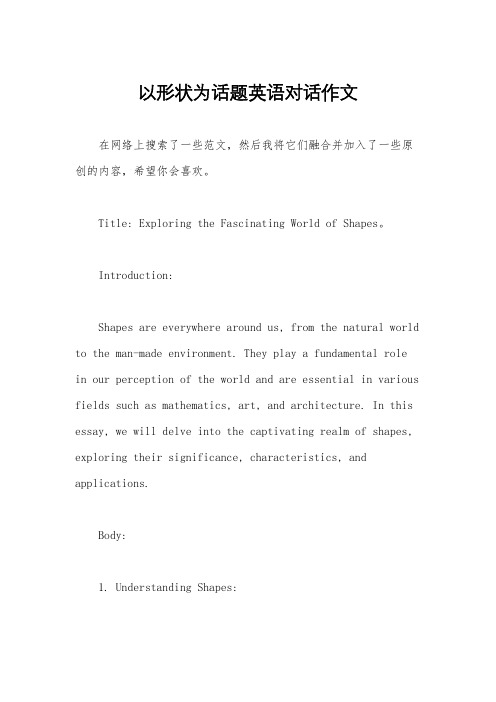
以形状为话题英语对话作文在网络上搜索了一些范文,然后我将它们融合并加入了一些原创的内容,希望你会喜欢。
Title: Exploring the Fascinating World of Shapes。
Introduction:Shapes are everywhere around us, from the natural world to the man-made environment. They play a fundamental role in our perception of the world and are essential in various fields such as mathematics, art, and architecture. In this essay, we will delve into the captivating realm of shapes, exploring their significance, characteristics, and applications.Body:1. Understanding Shapes:Shapes are defined as the external form or appearance of an object. They can be categorized into basic shapes such as circles, squares, triangles, and rectangles, as well as complex shapes like polygons and irregular forms. Each shape has distinct properties that define its characteristics, including the number of sides, angles, and symmetry.2. Importance of Shapes in Mathematics:In mathematics, shapes are studied extensively in geometry. They serve as the foundation for understanding spatial relationships, measurement, and calculation. Basic geometric shapes are used to teach children fundamental mathematical concepts such as addition, subtraction, multiplication, and division. Moreover, advanced mathematical principles such as calculus and topology rely on the concept of shapes to solve complex problems.3. Shapes in Art and Design:Shapes are integral to the world of art and design.Artists use shapes to create visual compositions, convey emotions, and communicate ideas. Whether it's the geometric patterns in Islamic art, the abstract shapes in modern art movements like cubism, or the organic forms in nature-inspired designs, shapes play a crucial role in artistic expression. Furthermore, architects and designers utilize shapes in architectural plans, interior design, and product development to achieve balance, harmony, and functionality.4. Symbolism of Shapes:Shapes often carry symbolic meanings across different cultures and contexts. For example, the circle represents unity, wholeness, and eternity in many cultures, while the triangle symbolizes stability, balance, and progression. In religious symbolism, the cross is a significant shape representing faith and salvation. Understanding the symbolic significance of shapes enhances our appreciation of cultural traditions and rituals.5. Applications of Shapes in Everyday Life:Shapes have practical applications in various aspects of everyday life. From the shape of traffic signs guiding us on the road to the packaging of products on supermarket shelves, shapes influence our daily experiences. In technology, shapes are used in graphic design, user interface design, and industrial design to create visually appealing and user-friendly products. Moreover, in medicine and biology, understanding the shapes of molecules andcells is crucial for research and diagnosis.6. The Beauty of Geometric Patterns:Geometric patterns, characterized by repetitive shapes and symmetrical arrangements, captivate our senses with their mesmerizing beauty. From the intricate designs of Islamic architecture to the kaleidoscopic patterns found in nature, geometric shapes create visually stunning compositions that evoke a sense of harmony and order. Whether it's the hexagonal honeycomb structure of a beehive or the spiraling patterns of a seashell, geometric shapes abound in the natural world, inspiring artists, mathematicians, and designers alike.Conclusion:In conclusion, shapes are not merely geometric entities but integral components of our perception, expression, and understanding of the world. From the mathematical abstractions of Euclidean geometry to the artistic creations of renowned painters, shapes transcend disciplinary boundaries, enriching our lives with their beauty, significance, and versatility. By exploring the fascinating world of shapes, we gain insights into the interconnectedness of art, science, and culture, unlocking new avenues of creativity, knowledge, and appreciation.。
新托福口语常用句子
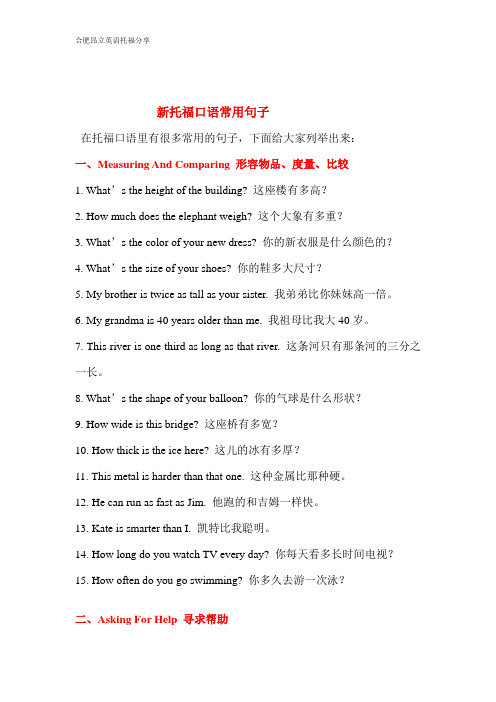
新托福口语常用句子在托福口语里有很多常用的句子,下面给大家列举出来:一、Measuring And Comparing 形容物品、度量、比较1. What’s the height of the building? 这座楼有多高?2. How much does the elephant weigh? 这个大象有多重?3. What’s the color of your new dress? 你的新衣服是什么颜色的?4. What’s the size of your shoes? 你的鞋多大尺寸?5. My brother is twice as tall as your sister. 我弟弟比你妹妹高一倍。
6. My grandma is 40 years older than me. 我祖母比我大40岁。
7. This river is one third as long as that river. 这条河只有那条河的三分之一长。
8. What’s the shape of your balloon? 你的气球是什么形状?9. How wide is this bridge? 这座桥有多宽?10. How thick is the ice here? 这儿的冰有多厚?11. This metal is harder than that one. 这种金属比那种硬。
12. He can run as fast as Jim. 他跑的和吉姆一样快。
13. Kate is smarter than I. 凯特比我聪明。
14. How long do you watch TV every day? 你每天看多长时间电视?15. How often do you go swimming? 你多久去游一次泳?二、Asking For Help 寻求帮助16. Would you please open the door for me? 请你帮忙开个门好吗?17. May I ask you a question? 我能问你个问题吗?18. Please give me a hand. 请帮我个忙。
英语口语考试常见话题

英语口语考试常见话题英语口语考试常见话题在英语考试的阶段中,许多考生最担忧的的就是考试中的口语部分。
下面是我为你整理了英语口语考试常见话题,期望能帮忙到您。
1. What’s your name?2. Does your name have any special meaning?3. Where do you come from?4. What kind of landscape surrounds your hometown?5. What is the main crop in your hometown?6. What is the difference between Beijing and your hometown?7. What are the main places of interest in your hometown?8. What is the climate like in your hometown?9. What is the character of the people like in the region where you live?10. What are the differences in accent between the people of your hometown and Beijing?11. What is people’s favorite food in your region?12. How do you make dumplings?13. What do you do during the Spring Festival?14. Why is the Spring Festival so important to Chinese people?15. Can you describe one of the main festivals celebrated in your country?16. Tell me something about the Lantern Festival.17. Tell me something about the Qing Ming Festival.18. Tell me something about the customs of your country.19. How long have you lived in Beijing?20. What is the weather like in Beijing?21. How do you compare the climate in Beijing with that in your hometown?22. What place in Beijing do you like best? Why ?23. Which is the worst place you’ve been to China?24. Which is the bes t place you’ve been to China?25. What places in Beijing should a foreigner visit? Why?26. What are the major social problems in Beijing? How can they be solved?27. What is the biggest problem China faces?28. What troubles you most at the moment?29. Could you tell me something about your family?30. Have you any children?31. What is your child’s name? Does his name have a meaning?32. What does your wife/husband do?33. When did you get married?34. Describe your wedding.35. How have weddings changed in recent years?36. Are there any special customs about wedding in your region?37. Describe a traditional wedding ceremony.38. Where did you go for your honeymoon?39. Did you have to ask for permission from your parents before you got married?40. Is it acceptable for couples to live together without marrying?41. Where do you think a newly couple should live? Living with their parents or on their own?42. What responsibilities should a couple take?43. How do Chinese usually celebrate birthdays?44. Are there any traditions concerning the birth of a baby?45. What kind of parent do you intend to be?46. What do you think of One-Child Policy in China?47. Why do people in China traditionally want to have a son?48. What difficulties do Chinese farmers have concerning their old age?49. What do you think needs to be done in order to relieve the farmer’s worri es?50. What hope or fears do you have for your children?51. What sort of culture do you hope your child will grow up in?52. Are you going to bring up your child differently fromthe way you were brought up? How?53. Do you enjoy shopping?54. Who does most of the shopping in your family?55. What are you good at cooking? What is your favorite dish?56. Who does most of cooking in your family?57. Is there sex discrimination in China?58. How do you su m up women’s conditions in China?59. What are the causes of sex discrimination?60. Should government pay certain salaries to those housewives? Why or why not?61. Would you want your wife to continue with her career or to stay at home taking care of the household after you get married?62. Have you ever wished to be one of the opposite sex? Why (why not)?63. What would you do if your next-door neighbour were noisy nearly all the time?64. Do you have a lot of friend?65. What does friendship mean to you? What kind of people do you make friend with?66. What is your major?67. How do you like your major?68. When and where did you graduate? What qualifications have you obtained?69. Do you still remember your school days?70. What impressed you most when you were at university?71. Which is the best university in your country?72. Could you sum up your own study habits in a few points?73. What do you think of the practice of setting up key schools in primary and secondary school education in China?74. Do you think the subjects you are studying today are relevant to present-day society? Why ?75. What do you think education should be? Should it be a process of learning what is useful for your future life or should it be simply learning for enjoyment? Why?76. What do you do for a living?77. What do you do in the office every day?78. Since your job seems too professional to me, could you explain it in detail?79. What are your job prospects?80. If you had the opportunity to change your job, what would you do with it?81. Do you have any ambitious?82. Will any possible future changes affect your job in any way?83. What are your spare time interests?84. How do you spend your weekends?85. What is your favorite sport? What are the rules?86. What is the most popular sport in your country?87. What are the sporting facilities like in your university/Beijing?88. What do you know about Qigong? Do you believe in Qigong?89. What do you do in your spare time?90. Do you often read newspapers? If not, why ones do you read?91. What do you think of computer?92. Do you think computer has changed our life so much?93. Do you often go to the cinema/theatre?94. What kind of films do you like best?95. Do you often watch TV? What is your favorite program?96. Do you think watching TV too much is a waste of time?97. What kind of music do you enjoy?98. Who is your favorite film star? Will you describe him/her to me?99. Do you enjoy travelling?100. Where have you been travelling to? Which place interested you most?101. Do you smoking?102. Do you think smoking is a problem that needs special attention and has to be solved? If so, why?103. What do you know about XXX?104. What problem do you think you will have in XXX?105. How will you overcome the difficulties?106. Do you think you will be able to cope withEnglish-demands of your intended study program in XXX?107. What difficulties do you think you’ll encounter in your studies in XXX ?108. Can you imagine what life inBritain/Canada/Australia/London, etc. would be like?109. How will you fare in Britain/Canada/Australia, etc. without your family?110. What do you intend to study?111. Which university are you going to study at?112. Why did you choose this university?113. Where are you going to study in XXX?114. What are you plans in XXX?115. What is your research proposal all about?116. What do you hope for most from your study abroad?117. Will your study abroad help your job prospects after come back to China?118. Should you study more theory or do more practice? Give your reasons, please.119. What kind of differences in the cultures are you expecting between China and the XX?120. How will your study in Britain benefit your work in China when you come back to China?121. What do you intend to do after you finish studying?122. What will be your main problem when you are study in a foreign country?123. What problem can you foresee in the future when you come back to China?124. Will there be any adjustment problems in your life when you come back to China? If so, what are they?125. Will you have to make any changes in your work/life when you come back to China?126. Do you think there will be a gap between your knowledge gained in China and the level of knowledge you are going to encounter on arrival? If so, what will it be?127. What do you think of the future of China keeps an open policy?128. What do you regard as the most significant events in your country’s recent history?129. Are there any special places you want to see in Canada? What are they?130. What do you especially want to do in Canada?131. How do you like your life in ******* University?132. What do you think of the training in the university?133. In what way do you think university training is helpful or falls short?134. What aspect of English do you find the most difficult?135. Do you find American English easier to understand than Britain English?136. What sports are played in your country?137. Could you desc ribe the traditional architecture of your country?138. What role dose religion play in everyday life in your country?139. What would you regard as the most significant events in your country’s recent history?140. How aware do you think people are nowadays about environmental issues?141. Could you tell me why you chose to study at the university of ****?142. What role dose tourism play in your country’s economy?143. How serious is unemployment in your country?144. In your opinion, what are the most serious problems associated with modern life?145. What do you think have been the most important changes in your field over the past 5 years?146. What are you going to major in ?147. Are you going to do your own cooking when you are at university?148. Some local students feel that overseas students get preferential treatment. What is your opinion?149. Do you think you will be able to cope with the English-language demands of your intended program?150. What do you think are the main causes of road accidents?151. Do you think the government is doing enough to prevent road accidents?152. As there are more and more private cars, what do you think the government should do in order to encourage citizens to use public transport?153. How do you see yourself in ten years’ time?154. Have you ever thought to have your own business?155. What business do you hope to have?156. Do you know about any policies about opening a business abroad?157. What are your plans for your future?158. Why do you think there are more and more people leaving to immigrate to other countries?159. Is it good for China that so many people are going to other countries?160. Will your life change a lot after you immigrate to XXX?161. What will you do if you are ill abroad?162. Do you know what to do in case of emergency?163. What will do if you cannot find a job in XXX?164. Why do you want to immigrate to XXX?165. What will you do after the IELTS test?166. What will do if you fail the IELTS test? 167. How long have you been learning English? Reception 接待1. Do you find anything you like?你找到你喜爱的吗?2. What can I do for you?你要些什么?3. Can I help you?我能帮你吗?(需要些什么?)4. Are you being helped?/Are you being served?你需要帮忙吗?5. Is there anybody waiting on you?有人招呼你吗?Choosing and buying选择与购买Choosing 选择1. I want a pair of shoes/a jacket.我想买一双鞋/一件夹克。
幼儿园中班英语教案shapes
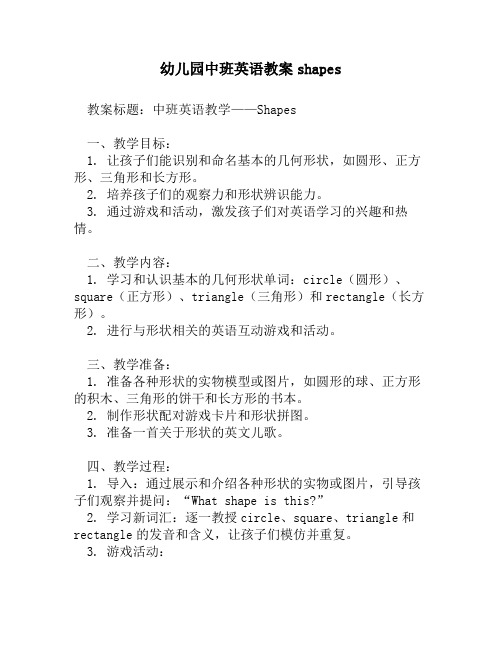
幼儿园中班英语教案shapes教案标题:中班英语教学——Shapes一、教学目标:1. 让孩子们能识别和命名基本的几何形状,如圆形、正方形、三角形和长方形。
2. 培养孩子们的观察力和形状辨识能力。
3. 通过游戏和活动,激发孩子们对英语学习的兴趣和热情。
二、教学内容:1. 学习和认识基本的几何形状单词:circle(圆形)、square(正方形)、triangle(三角形)和rectangle(长方形)。
2. 进行与形状相关的英语互动游戏和活动。
三、教学准备:1. 准备各种形状的实物模型或图片,如圆形的球、正方形的积木、三角形的饼干和长方形的书本。
2. 制作形状配对游戏卡片和形状拼图。
3. 准备一首关于形状的英文儿歌。
四、教学过程:1. 导入:通过展示和介绍各种形状的实物或图片,引导孩子们观察并提问:“What shape is this?”2. 学习新词汇:逐一教授circle、square、triangle和rectangle的发音和含义,让孩子们模仿并重复。
3. 游戏活动:- 形状配对游戏:将形状单词卡片和相应的形状图片混合,让孩子们匹配并说出形状的英文名称。
- 形状拼图:提供包含不同形状的拼图,让孩子们在完成拼图的同时,练习形状的英文表达。
- 唱英文儿歌:演唱关于形状的英文儿歌,增强孩子们的记忆和理解。
4. 总结回顾:再次展示各种形状,让孩子们用英语说出它们的名称。
五、教学延伸:鼓励孩子们在生活中寻找和识别这些形状,如家中的家具、玩具等,并尝试用英语描述。
六、教学总结:本次课程我们学习了四种基本的几何形状及其英文名称,通过游戏和活动,孩子们不仅提高了形状辨识能力,也初步接触和实践了英语口语表达。
七、教学评估:1. 观察和记录孩子们在课堂上的参与度和反应,了解他们对形状和英语词汇的理解程度。
2. 在课后进行形状辨识和英文表述的小测试,以评估孩子们的学习效果。
3. 鼓励家长参与评价,反馈孩子在家中的形状发现和英语使用情况。
shapes少儿英语形状
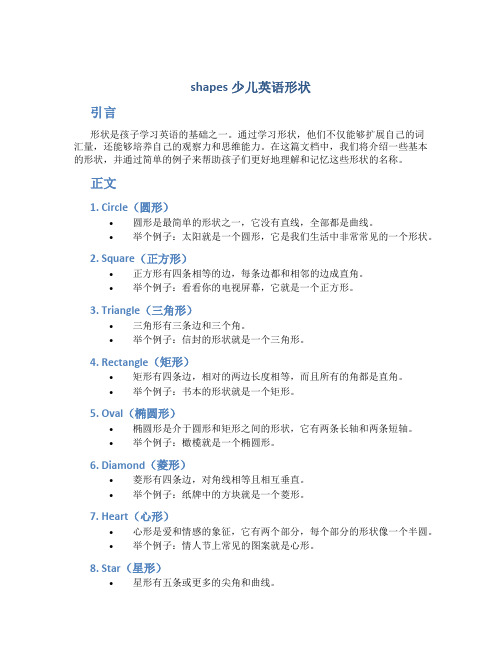
shapes少儿英语形状引言形状是孩子学习英语的基础之一。
通过学习形状,他们不仅能够扩展自己的词汇量,还能够培养自己的观察力和思维能力。
在这篇文档中,我们将介绍一些基本的形状,并通过简单的例子来帮助孩子们更好地理解和记忆这些形状的名称。
正文1. Circle(圆形)•圆形是最简单的形状之一,它没有直线,全部都是曲线。
•举个例子:太阳就是一个圆形,它是我们生活中非常常见的一个形状。
2. Square(正方形)•正方形有四条相等的边,每条边都和相邻的边成直角。
•举个例子:看看你的电视屏幕,它就是一个正方形。
3. Triangle(三角形)•三角形有三条边和三个角。
•举个例子:信封的形状就是一个三角形。
4. Rectangle(矩形)•矩形有四条边,相对的两边长度相等,而且所有的角都是直角。
•举个例子:书本的形状就是一个矩形。
5. Oval(椭圆形)•椭圆形是介于圆形和矩形之间的形状,它有两条长轴和两条短轴。
•举个例子:橄榄就是一个椭圆形。
6. Diamond(菱形)•菱形有四条边,对角线相等且相互垂直。
•举个例子:纸牌中的方块就是一个菱形。
7. Heart(心形)•心形是爱和情感的象征,它有两个部分,每个部分的形状像一个半圆。
•举个例子:情人节上常见的图案就是心形。
8. Star(星形)•星形有五条或更多的尖角和曲线。
•举个例子:国旗上通常都有一个星形图案。
通过学习这些形状,孩子们可以更好地理解和记忆它们的名称。
这些形状不仅仅是孩子们学习英语的一部分,也是他们日常生活中所见到的物体的外观。
希望这篇文档能够帮助孩子们更好地掌握这些形状的名称,为他们未来的学习打下坚实的基础。
以上就是关于shapes少儿英语形状的介绍,希望对您有所帮助。
注:本文档仅供参考,如需准确资料,请参考相关教材。
英语日常对话精选用语
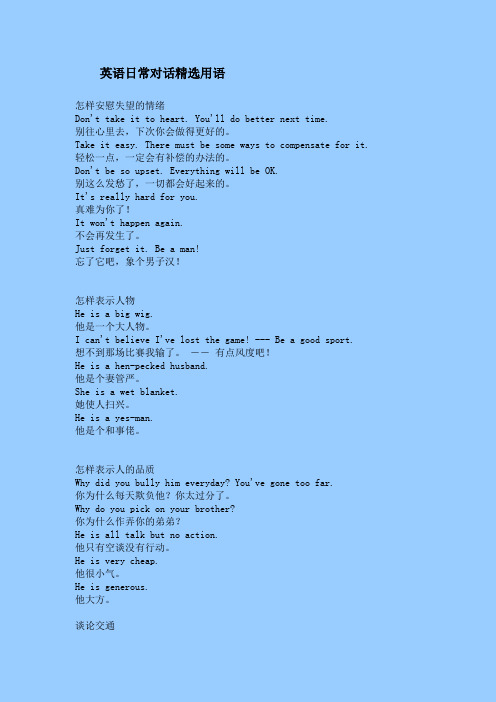
英语日常对话精选用语怎样安慰失望的情绪Don't take it to heart. You'll do better next time.别往心里去,下次你会做得更好的。
Take it easy. There must be some ways to compensate for it. 轻松一点,一定会有补偿的办法的。
Don't be so upset. Everything will be OK.别这么发愁了,一切都会好起来的。
It's really hard for you.真难为你了!It won't happen again.不会再发生了。
Just forget it. Be a man!忘了它吧,象个男子汉!怎样表示人物He is a big wig.他是一个大人物。
I can't believe I've lost the game! --- Be a good sport.想不到那场比赛我输了。
――有点风度吧!He is a hen-pecked husband.他是个妻管严。
She is a wet blanket.她使人扫兴。
He is a yes-man.他是个和事佬。
怎样表示人的品质Why did you bully him everyday? You've gone too far.你为什么每天欺负他?你太过分了。
Why do you pick on your brother?你为什么作弄你的弟弟?He is all talk but no action.他只有空谈没有行动。
He is very cheap.他很小气。
He is generous.他大方。
谈论交通He got a ticket yesterday.他得到一张处罚单。
You ran a red light.你闯红灯了。
You nearly ran into the bus.你差点撞上那辆公共汽车。
疯狂口腔肌肉训练情景英语
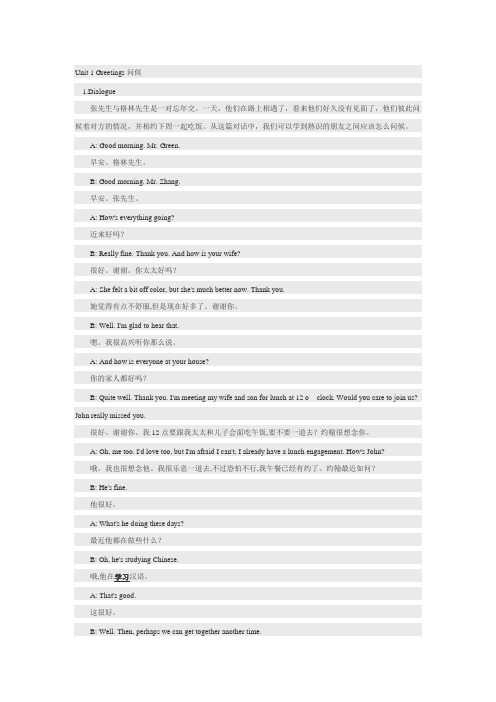
Unit 1 Greetings问候1.Dialogue张先生与格林先生是一对忘年交。
一天,他们在路上相遇了,看来他们好久没有见面了,他们彼此问候着对方的情况,并相约下周一起吃饭。
从这篇对话中,我们可以学到熟识的朋友之间应该怎么问候。
A: Good morning. Mr. Green.早安。
格林先生。
B: Good morning. Mr. Zhang.早安。
张先生。
A: How's everything going?近来好吗?B: Really fine. Thank you. And how is your wife?很好。
谢谢。
你太太好吗?A: She felt a bit off color, but she's much better now. Thank you.她觉得有点不舒服,但是现在好多了。
谢谢你。
B: Well. I'm glad to hear that.嗯。
我很高兴听你那么说。
A: And how is everyone at your house?你的家人都好吗?B: Quite well. Thank you. I'm meeting my wife and son for lunch at 12 o clock. Would you care to join us? John really missed you.很好。
谢谢你。
我12点要跟我太太和儿子会面吃午饭,要不要一道去?约翰很想念你。
A: Oh, me too. I'd love too, but I'm afraid I can't, I already have a lunch engagement. How's John?哦,我也很想念他。
我很乐意一道去,不过恐怕不行,我午餐已经有约了。
约翰最近如何?B: He's fine.他很好。
雅思口语part2素材之物品类
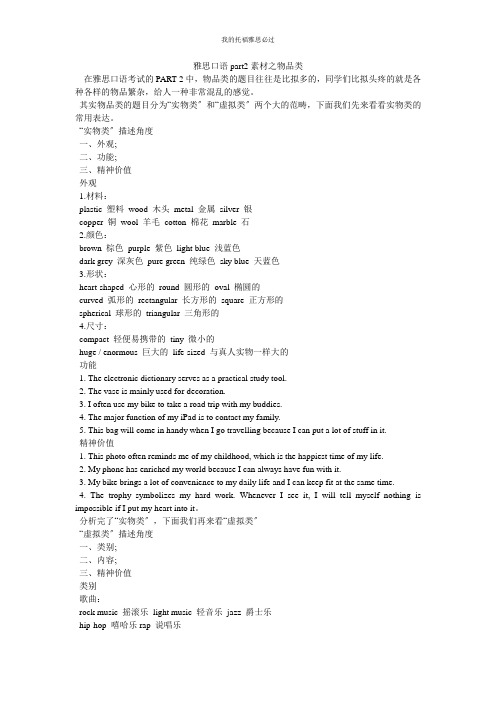
雅思口语part2素材之物品类在雅思口语考试的PART 2中,物品类的题目往往是比拟多的,同学们比拟头疼的就是各种各样的物品繁杂,给人一种非常混乱的感觉。
其实物品类的题目分为“实物类〞和“虚拟类〞两个大的范畴,下面我们先来看看实物类的常用表达。
“实物类〞描述角度一、外观;二、功能;三、精神价值外观1.材料:plastic 塑料wood 木头metal 金属silver 银copper 铜wool 羊毛cotton 棉花marble 石2.颜色:brown 棕色purple 紫色light blue 浅蓝色dark grey 深灰色pure green 纯绿色sky blue 天蓝色3.形状:heart-shaped 心形的round 圆形的oval 椭圆的curved 弧形的rectangular 长方形的square 正方形的spherical 球形的triangular 三角形的4.尺寸:compact 轻便易携带的tiny 微小的huge / enormous 巨大的life-sized 与真人实物一样大的功能1. The electronic dictionary serves as a practical study tool.2. The vase is mainly used for decoration.3. I often use my bike to take a road trip with my buddies.4. The major function of my iPad is to contact my family.5. This bag will come in handy when I go travelling because I can put a lot of stuff in it.精神价值1. This photo often reminds me of my childhood, which is the happiest time of my life.2. My phone has enriched my world because I can always have fun with it.3. My bike brings a lot of convenience to my daily life and I can keep fit at the same time.4. The trophy symbolizes my hard work. Whenever I see it, I will tell myself nothing is impossible if I put my heart into it。
三年级英文shapes作文
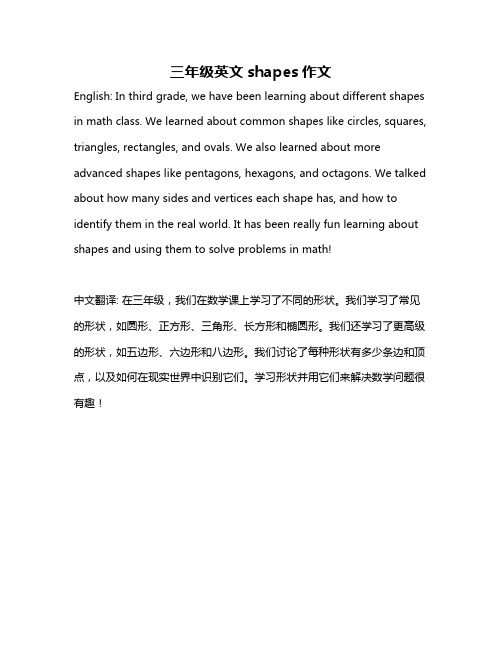
三年级英文shapes作文
English: In third grade, we have been learning about different shapes in math class. We learned about common shapes like circles, squares, triangles, rectangles, and ovals. We also learned about more advanced shapes like pentagons, hexagons, and octagons. We talked about how many sides and vertices each shape has, and how to identify them in the real world. It has been really fun learning about shapes and using them to solve problems in math!
中文翻译: 在三年级,我们在数学课上学习了不同的形状。
我们学习了常见的形状,如圆形、正方形、三角形、长方形和椭圆形。
我们还学习了更高级的形状,如五边形、六边形和八边形。
我们讨论了每种形状有多少条边和顶点,以及如何在现实世界中识别它们。
学习形状并用它们来解决数学问题很有趣!。
小学英语精讲精析 Shapes2
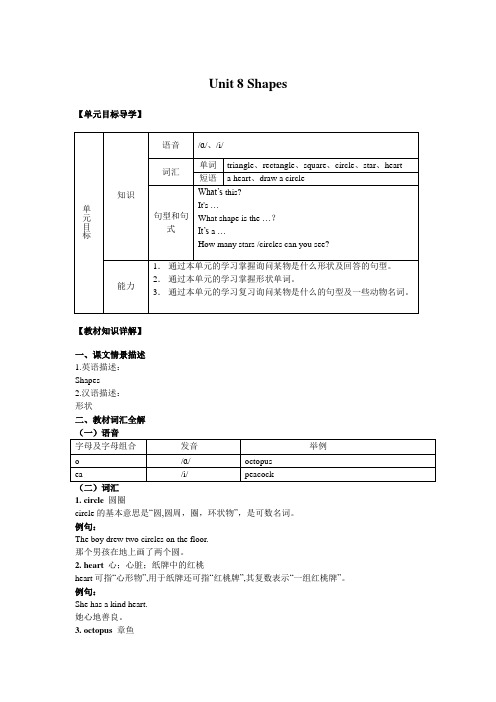
Unit 8 Shapes【单元目标导学】【教材知识详解】一、课文情景描述1.英语描述:Shapes2.汉语描述:形状二、教材词汇全解(一)语音(二)词汇1. circle 圆圈circle的基本意思是“圆,圆周,圈,环状物”,是可数名词。
例句:The boy drew two circles on the floor.那个男孩在地上画了两个圆。
2. heart 心;心脏;纸牌中的红桃heart可指“心形物”,用于纸牌还可指“红桃牌”,其复数表示“一组红桃牌”。
例句:She has a kind heart.她心地善良。
3. octopus章鱼用作名词(n.)例句:An octopus has suckers on its tentacles.章鱼的腕足上有吸盘。
4. ostrich鸵鸟用作名词(n.)例句:Ostrich is a type of large bird that can run very fast.鸵鸟是一种跑得很快的大鸟。
5. peacock孔雀用作名词(n.)例句:The peacock displayed its fan.孔雀展开了它的尾巴。
6. pig 猪用作名词(n.)例句:He keeps pigs as a career.他以养猪为业。
7. rectangle长方形;长方形的用作名词(n.)例句:A rectangle has four right angles.一个矩形有四个直角。
8. square 正方形square用作名词时基本意思是“正方形,方块”,引申可指“广场,广场四周的建筑物,平方,四角,方阵,直角尺,街区,小方格纵横字谜”等,是可数名词。
例句:The table is square.桌子是正方形的。
9. star 星,恒星star用作动词的意思是指用星状物来为某物作标记或进行装饰,即“标示,点缀”。
star还可指“主演”,即在一部影片中充当主角,有时也可指“使(某人)走红”。
英语日常用语之形容物品、度量、比
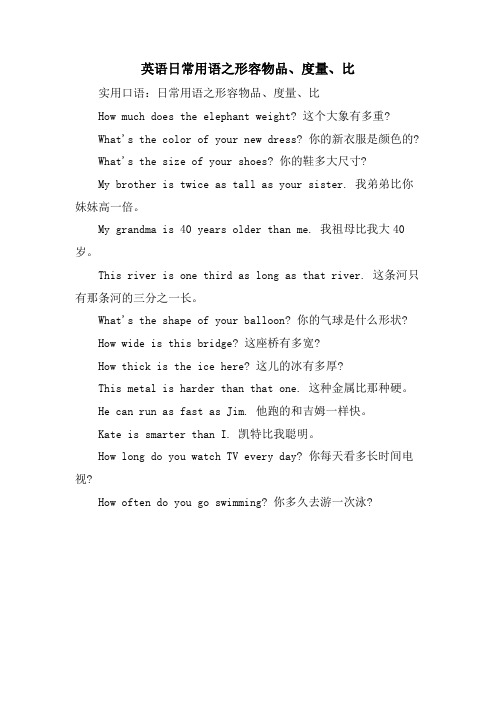
英语日常用语之形容物品、度量、比
实用口语:日常用语之形容物品、度量、比
How much does the elephant weight? 这个大象有多重?
What's the color of your new dress? 你的新衣服是颜色的?
What's the size of your shoes? 你的鞋多大尺寸?
My brother is twice as tall as your sister. 我弟弟比你妹妹高一倍。
My grandma is 40 years older than me. 我祖母比我大40岁。
This river is one third as long as that river. 这条河只有那条河的三分之一长。
What's the shape of your balloon? 你的气球是什么形状?
How wide is this bridge? 这座桥有多宽?
How thick is the ice here? 这儿的冰有多厚?
This metal is harder than that one. 这种金属比那种硬。
He can run as fast as Jim. 他跑的和吉姆一样快。
Kate is smarter than I. 凯特比我聪明。
How long do you watch TV every day? 你每天看多长时间电视?
How often do you go swimming? 你多久去游一次泳?。
英语情景口语:personalappearance相貌
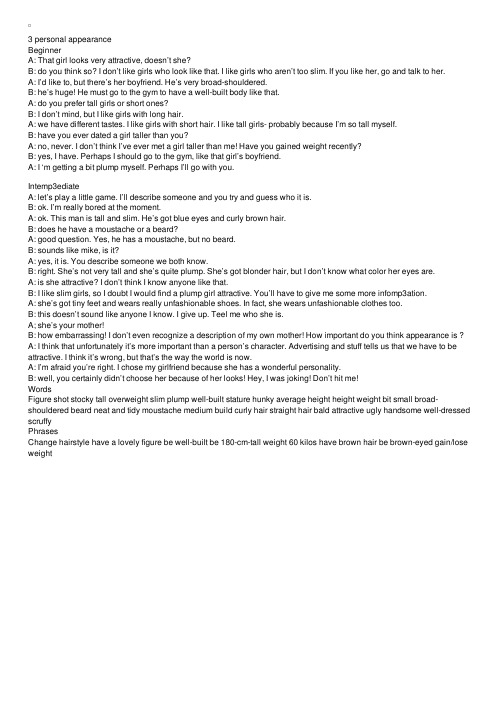
3 personal appearanceBeginnerA: That girl looks very attractive, doesn’t she?B: do you think so? I don’t like girls who look like that. I like girls who aren’t too slim. If you like her, go and talk to her.A: I’d like to, but there’s her boyfriend. He’s very broad-shouldered.B: he’s huge! He must go to the gym to have a well-built body like that.A: do you prefer tall girls or short ones?B: I don’t mind, but I like girls with long hair.A: we have different tastes. I like girls with short hair. I like tall girls- probably because I’m so tall myself.B: have you ever dated a girl taller than you?A: no, never. I don’t think I’ve ever met a girl taller than me! Have you gained weight recently?B: yes, I have. Perhaps I should go to the gym, like that girl’s boyfriend.A: I ‘m getting a bit plump myself. Perhaps I’ll go with you.Intemp3ediateA: let’s play a little game. I’ll describe someone and you try and guess who it is.B: ok. I’m really bored at the moment.A: ok. This man is tall and slim. He’s got blue eyes and curly brown hair.B: does he have a moustache or a beard?A: good question. Yes, he has a moustache, but no beard.B: sounds like mike, is it?A: yes, it is. You describe someone we both know.B: right. She’s not very tall and she’s quite plump. She’s got blonder hair, but I don’t know what color her eyes are.A: is she attractive? I don’t think I know anyone like that.B: I like slim girls, so I doubt I would find a plump girl attractive. You’ll have to give me some more infomp3ation.A: she’s got tiny feet and wears really unfashionable shoes. In fact, she wears unfashionable clothes too.B: this doesn’t sound like anyone I know. I give up. Teel me who she is.A; she’s your mother!B: how embarrassing! I don’t even recognize a description of my own mother! How important do you think appearance is ? A: I think that unfortunately it’s more important than a person’s character. Advertising and stuff tells us that we have to be attractive. I think it’s wrong, but that’s the way the world is now.A: I’m afraid you’re right. I chose my girlfriend because she has a wonderful personality.B: well, you certainly didn’t choose her because of her looks! Hey, I was joking! Don’t hit me!WordsFigure shot stocky tall overweight slim plump well-built stature hunky average height height weight bit small broad-shouldered beard neat and tidy moustache medium build curly hair straight hair bald attractive ugly handsome well-dressed scruffyPhrasesChange hairstyle have a lovely figure be well-built be 180-cm-tall weight 60 kilos have brown hair be brown-eyed gain/lose weight。
大学英语描述大小和形状的作文
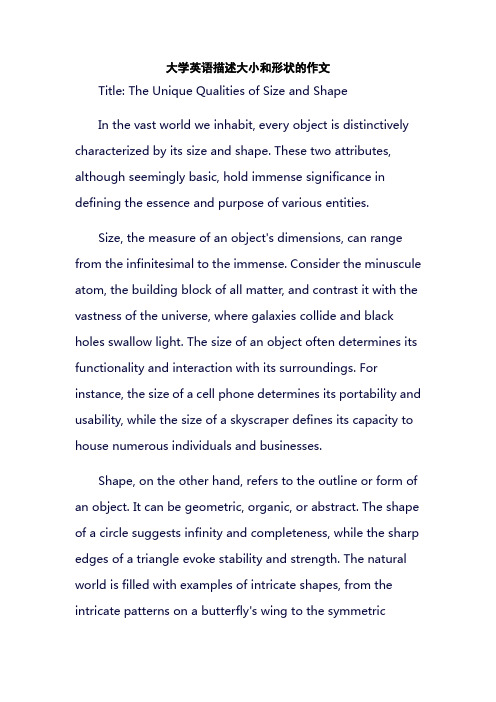
大学英语描述大小和形状的作文Title: The Unique Qualities of Size and ShapeIn the vast world we inhabit, every object is distinctively characterized by its size and shape. These two attributes, although seemingly basic, hold immense significance in defining the essence and purpose of various entities.Size, the measure of an object's dimensions, can range from the infinitesimal to the immense. Consider the minuscule atom, the building block of all matter, and contrast it with the vastness of the universe, where galaxies collide and black holes swallow light. The size of an object often determines its functionality and interaction with its surroundings. For instance, the size of a cell phone determines its portability and usability, while the size of a skyscraper defines its capacity to house numerous individuals and businesses.Shape, on the other hand, refers to the outline or form of an object. It can be geometric, organic, or abstract. The shape of a circle suggests infinity and completeness, while the sharp edges of a triangle evoke stability and strength. The natural world is filled with examples of intricate shapes, from the intricate patterns on a butterfly's wing to the symmetriccontours of a snowflake. The shape of an object can also influence its function; for example, the aerodynamic shape of an airplane's wing allows it to slice through the air efficiently.In conclusion, size and shape are fundamental aspects of our understanding of the world. They influence not only the physical characteristics of objects but also their functionality, interaction, and often, their perceived value. Appreciating the uniqueness of size and shape is crucial in comprehending the diversity and complexity of the universe we inhabit.。
日常英语口语教程:描述长宽高重及颜色
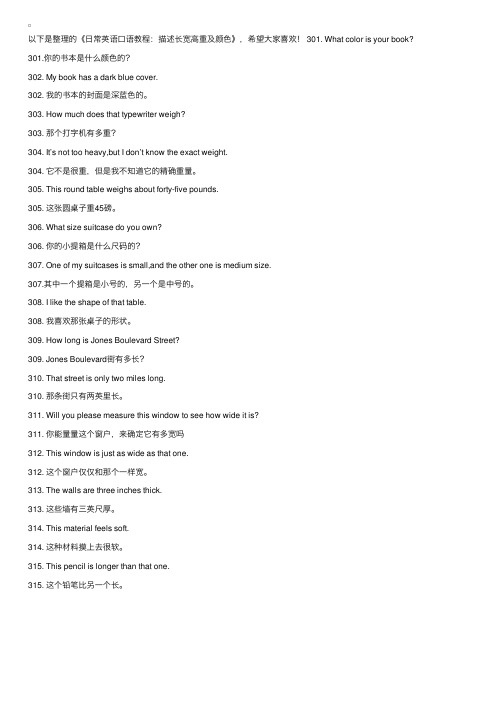
以下是整理的《⽇常英语⼝语教程:描述长宽⾼重及颜⾊》,希望⼤家喜欢! 301. What color is your book? 301.你的书本是什么颜⾊的?302. My book has a dark blue cover.302. 我的书本的封⾯是深蓝⾊的。
303. How much does that typewriter weigh?303. 那个打字机有多重?304. It’s not too heavy,but I don’t know the exact weight.304. 它不是很重,但是我不知道它的精确重量。
305. This round table weighs about forty-five pounds.305. 这张圆桌⼦重45磅。
306. What size suitcase do you own?306. 你的⼩提箱是什么尺码的?307. One of my suitcases is small,and the other one is medium size.307.其中⼀个提箱是⼩号的,另⼀个是中号的。
308. I like the shape of that table.308. 我喜欢那张桌⼦的形状。
309. How long is Jones Boulevard Street?309. Jones Boulevard街有多长?310. That street is only two miles long.310. 那条街只有两英⾥长。
311. Will you please measure this window to see how wide it is?311. 你能量量这个窗户,来确定它有多宽吗312. This window is just as wide as that one.312. 这个窗户仅仅和那个⼀样宽。
313. The walls are three inches thick.313. 这些墙有三英尺厚。
雅思口语如何描述一件物品
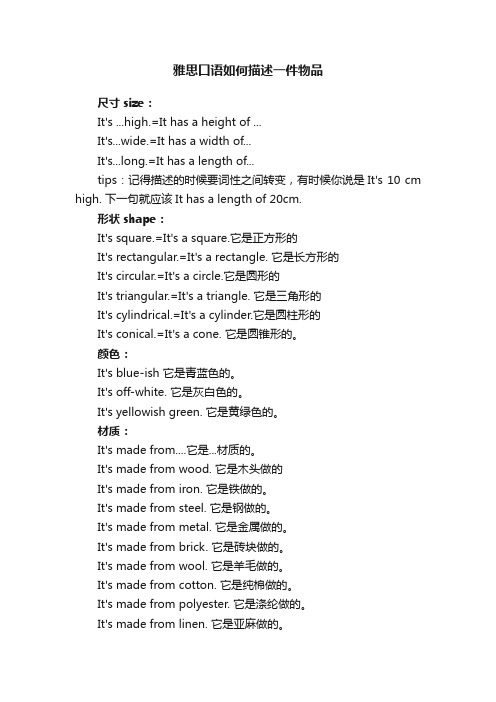
雅思口语如何描述一件物品尺寸size:It's ...high.=It has a height of ...It's...wide.=It has a width of...It's...long.=It has a length of...tips:记得描述的时候要词性之间转变,有时候你说是It's 10 cm high. 下一句就应该It has a length of 20cm.形状shape:It's square.=It's a square.它是正方形的It's rectangular.=It's a rectangle. 它是长方形的It's circular.=It's a circle.它是圆形的It's triangular.=It's a triangle. 它是三角形的It's cylindrical.=It's a cylinder.它是圆柱形的It's conical.=It's a cone. 它是圆锥形的。
颜色:It's blue-ish 它是青蓝色的。
It's off-white. 它是灰白色的。
It's yellowish green. 它是黄绿色的。
材质:It's made from....它是...材质的。
It's made from wood. 它是木头做的It's made from iron. 它是铁做的。
It's made from steel. 它是钢做的。
It's made from metal. 它是金属做的。
It's made from brick. 它是砖块做的。
It's made from wool. 它是羊毛做的。
It's made from cotton. 它是纯棉做的。
- 1、下载文档前请自行甄别文档内容的完整性,平台不提供额外的编辑、内容补充、找答案等附加服务。
- 2、"仅部分预览"的文档,不可在线预览部分如存在完整性等问题,可反馈申请退款(可完整预览的文档不适用该条件!)。
- 3、如文档侵犯您的权益,请联系客服反馈,我们会尽快为您处理(人工客服工作时间:9:00-18:30)。
情景英语口语100主题 092size and shape
尺寸和形状
92 size and shape
words
large enormous tiny microscopic average medium short width thin thick circular square rectangle rectangular height oval triangular semi-circle cube sphere three-dimensional pyramid diamond star-shaped cylindrical round spherical shallow vast
phrases
shape like a ….
Have dimensions of
Have (5) sides
(bigger) than average
(be) in the shape of
Beginner
A: what book is that?
B: I just bought a new atlas. I’m looking this map of the world. Look at Russia! That’s a vast country.
A: Canada, china, and the use are huge too.
B; there are several tiny countries in the world too. Countries like Monaco are smaller than many cities.
A: those small countries are microscopic compared to Russia. European countries are relatively small. France looks quite big in Europe, but compared to many countries in other continents, it’s not very large at all.
B: britain is half the size of france, but great Britain is still one of the largest islands in the world.
A; the thing with large countries is that often they have vast areas of land that are useless or hardly used. Russia and Canada have enormous areas of ice and forest.
Intermediate
A: that looks like an interesting book.
B: it is. It’s got pictures of interesting building from all over the world, with brief descriptions of how they were build, their purpose, and so on.
A: there are the pyramids. It’s easy to see how they got that name! they don’t have smooth sides though.
B: they don’t now, but most of them did originally. There’s picture of the pentagon in the united states. It’s very distinctive with its five sides.
A; look at that cylindrical office building. I’ve never been seen one that shape before.
B; yes. Usually only towers are cylindrical in shape.
A: tv towers are usually thicker at the bottom than at the top. They’re not perfectly cylindrical.
B: this is the world’s largest sports stadium. It’s a massive oval.
A; what sports do they play there?
B: it says here that it’s mainly used for big football matches and athletics meetings.
A: is that building a perfect cube?
B: according to the book, it is. I’ve never seen a building that is a perfect cube. Look at the building. From the air, it looks like a square with a semi-circle attached to each of its four sides. What kind of building is it?
A: is says here that it’s a war memorial. Now, there’s a distinctive structure-the atomium in Brussels. See? It consists of several connected by cylinders. I believe you can go up and down inside it.。
